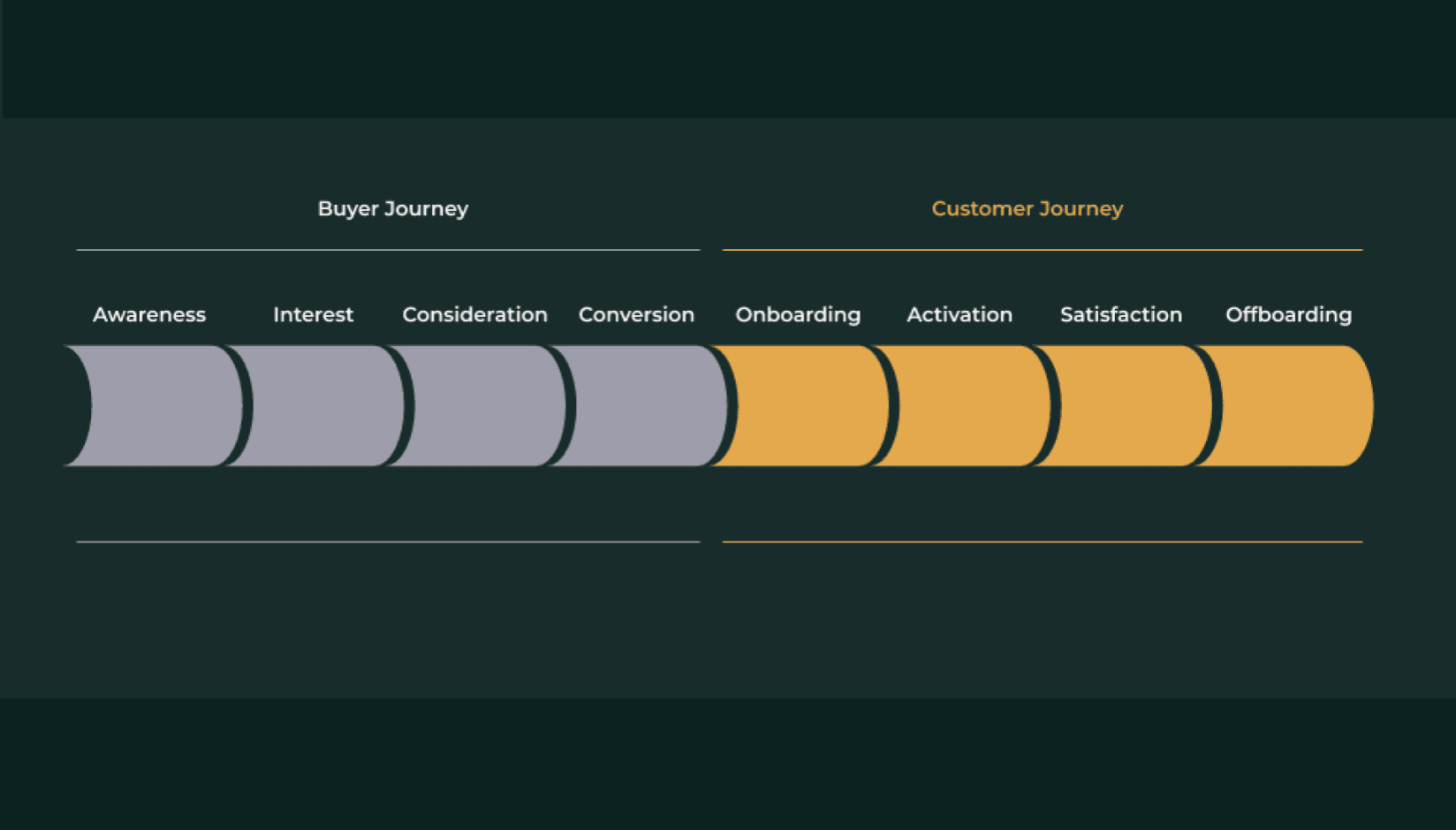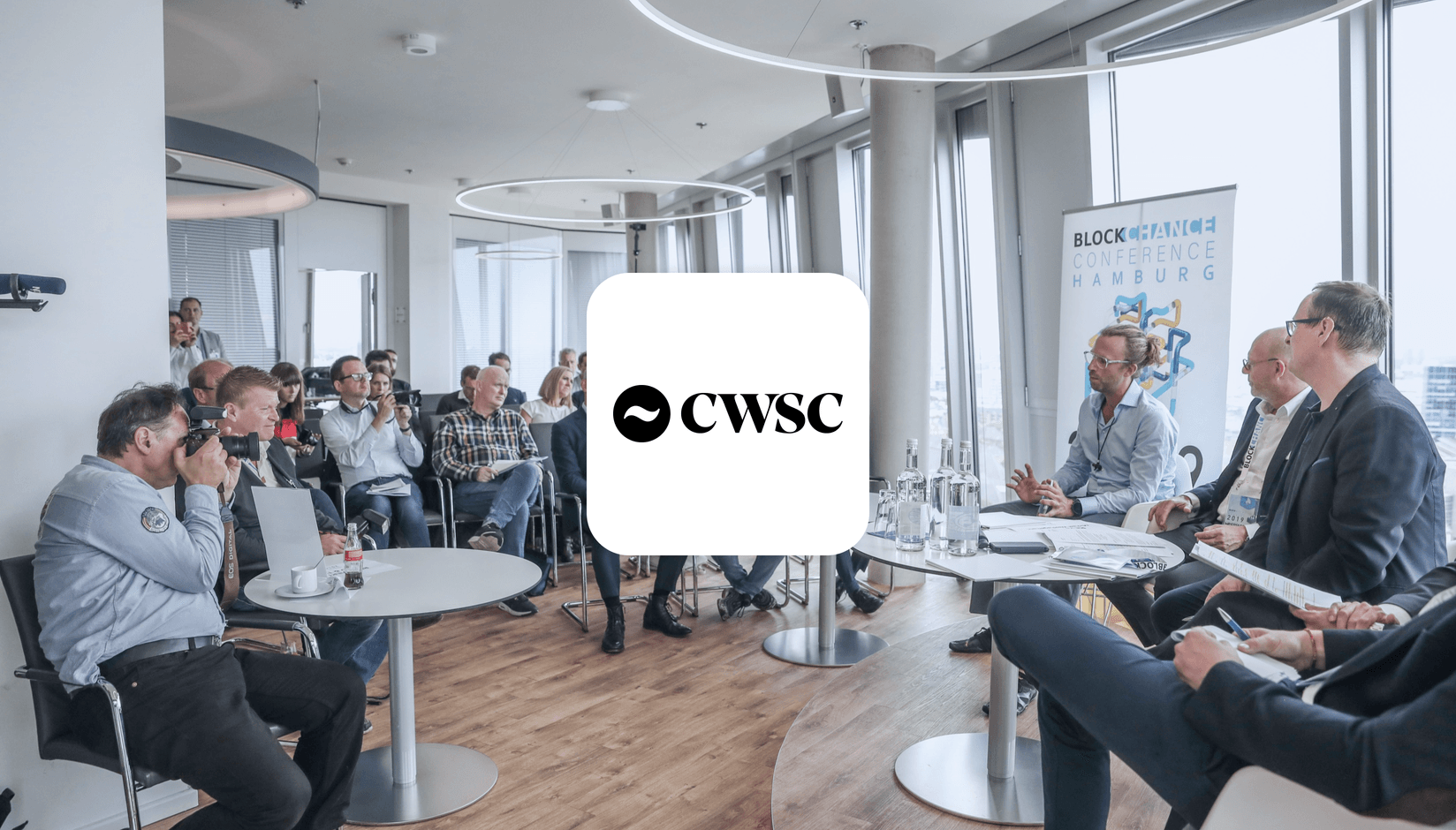- Features
- Solutions
- Pricing
- Resources
- Contact
- Book a demo

Table of Contents
Having experienced coworking spaces both as a member as well as a business partner perspective, I have seen how the design of a customer journey impacts the lives of coworking space members. Whether you operate a single location coworking space or a mature multi-location flex space network, your success ultimately depends on your ability to activate and satisfy customers.
In this article, I share some insights that I learned from hundreds of flex spaces.
Instead of giving you a general theoretical outline, I prefer to share a few practical tips that could help you build an amazing customer journey.
Customer Journey Funnel
You have surely heard about the sales funnel with its awareness, interest, consideration, and conversion stages. Once a lead converts into a customer at the last stage of a sales process, it enters into a customer journey funnel.

I want to point out a clear difference between these two funnels. By building a sales funnel, your goal is to convert the buyer as fast as possible, shortening the path. With the customer journey funnel, your goal is to actually extend it as much as possible to make your residents stay with you longer. That’s why the most effective buyer journey is executed by sales representatives, while the customer journey is usually taken care of by your community manager. These two roles and processes are guided by a deeply differentiated motivation and set of principles.
Starting from onboarding when you're greeting and introducing your customer to your infrastructure, going through the activation that improves engagement of your customers, to workspace satisfaction and offboarding, it's very important to design the lifecycle of your members throughout every stage.
I will share some insights, tips, and strategies that will help you do that. I am not going to discuss some common practices like sending monthly newsletters or hosting events. My goal is to give you some new ideas that you could try and experiment with. And we are starting with onboarding.
1. The Onboarding Stage
Onboarding is your opportunity to introduce a customer to all the necessary infrastructure and when I say a coworking space customer, I don't only mean the one who’s paying, but rather every team member. Every one of them deserves access to all the necessary infrastructure such as bookings, printing, WiFi, smart locks, and doors access. You might be tempted to satisfy only the payer, who’s an ultimate decision-maker, after all. Nowadays, however, companies are growing fast, and today’s common team member could become a decision-maker tomorrow. Besides, any healthy company would always strive to consider all employees’ opinions when making a decision to extend a rental agreement.
There are several areas to explore with the first one being member registration.
Registration of Members
Of course, you don't want your new residents to run up to the front desk every time they need something — booking, printing, connecting to Wi-Fi, getting access to doors, and so on. It's very important to organize this process and make it as simple as possible for your members.
Ideally, you can enable the self-registration of customers in all your systems. For example, you can use Google forms of Typeform for capturing customer data and consents. Then, you can propagate this data into all your favorite apps using Zapier. You can use tools like HelloWorks to let your customers fill and self-generate data for processing consents or necessary documents that they need to sign digitally. Your coworking software could also enable a simple registration experience for your customers, automatically granting them access to all other infrastructure of your flex space.
When you push the data into all the systems you use, your customers don't have to subscribe to a million different sites and accounts. They get immediate access to all membership tools and benefits. You save time by reducing boring copy-pasting and routines.
Give Directions with an Onboarding Sequence
Onboarding and registration of your customers in all your apps can be overwhelming when you just give them so much information to digest upfront. It is better to give membership information bit by bit, gradually introducing various services, tools, and advantages that the coworking space membership gives.
Here is a wonderful example of such an approach for you — an onboarding sequence.
Modern mobile banks, marketplaces, and multiple online businesses are using email sequences to activate customers. Have you heard of or tried using an Internet bank like Revolut, Monese, or Monobank? Have you received the sequence of emails after signing up? They introduce various aspects of how to use app features, apply for credit, or inform about discounts.
Imagine something like that for your flex space tenants. Utilize tools like Mailchimp to build sequences introducing your customers step by step to various aspects of your business.
“Hey Alex, here are some free credits that you can use to book rooms and desks at your workspace!” — inform about their membership advantages, such as free hours credits.
“Alex, did you know that you’re now a part of a huge network of business professionals and like-minded people? Meet them all on our Community page!” — two-three days later, motivate customers to find friends.
“Hi Alex, share some love with your fellow community members — introduce yourself on Feed!” — a couple of days later, push customers to engage with your community by posting self-introductions on Feed community newsfeed.
It's a serviceable strategy that you can use for helping your customers onboard softly into your digital ecosystem.
Answer Questions
Building a knowledge base for frequently asked questions and answers will help customers find all the answers even if you’re not around. You can use tools like Intercom to create a knowledge center. It's really handy because when customers start sending a message on Intercom, the app will auto-suggest help articles based on the analysis of what the customer is typing.
Such powerful tools can save a lot of time to your administration personnel and give a customer immediate access to the information they need.
2. The Activation Stage
Now, once you onboarded all your customers, it doesn't mean they're going to start using your infrastructure actively. Customer activation is a big challenge at all flex workspace businesses. The topic of member activation and engagement previously appeared on Spacebring Blog.
Use various channels to guide your customers and keep them engaged with all your services. Probably you know and already utilize a multi-channel marketing strategy. Marketing at coworking spaces is typically understood as something facing outwards towards brand awareness or lead generation.
However, when it comes to your own customer base, you can also use marketing facing it internally to push certain events or information to your members, help them activate, and so on. Internal marketing is often limited to just sharing news about events with residents, but there is so much more to it.
Offline Surfaces

Use all available screens, desks, and walls to communicate opportunities that your customers have at your flex space. For instance, a TV hanging next to the cafe area can help push information to members, such as available rooms, desks, membership benefits, additional services, and more. A small paper stand at the reception or a sticker in the restroom cabin can help drive downloads of your membership apps.
Personalized Targeted Marketing
Surfaces like TV screens or printed materials are great broadcasting channels but you can also use a more targeted approach. Let's assume I'm a new coworking member and my name is Alex. I just moved in. As a coworking space operator, you don't know much about me, you don't know what I like, what are my preferences, what are my hobbies… But you really want to know all the above because you want to understand your target audience better and personalize services.
How do you really know what your customers like?
Prepare and send a newsletter using your own blog content or third-party resources. Compile various news topics that you think your customers might like. For example, one about tech, one about wellness, one about entertainment and food, and send this newsletter using Mailchimp or another service. Then set up a Zapier automation that automatically adds a user tag on Intercom depending on which link a customer clicked.
So, back to Alex, who just joined your workspace, interested in fitness and clicking on that seven-minute workout in your email newsletter. As soon as the link is clicked, a tag wellness is added to Alexs’ Intercom profile. Now you know that Alex is interested in sports.
Next, whenever a new benefit shows up in “Wellness” category, say a 50% discount on the nearby sports club services, you can use that Intercom tag to segment users into an audience interested in wellness. Prepare and send a push message through your own coworking apps suggesting users to check out this new benefit.
Use this approach to push relevant benefits and services that could be of certain interest to categories of your customers in a more personal, targeted way. Your members will appreciate your attentive and personalized approach, and that means higher activation rates across the board.
Generate recurring revenue and offer exceptional customer experience at your shared or coworking space
3. The Satisfaction Stage
Having worked on engagement, it's very important to work on the next step of the customer journey. This is to make sure customers are satisfied with your services and really want to keep staying or coming back.
We can look at satisfaction from the viewpoint of building relationships. Any business is about human relationships and inspiring a sense of feeling good. On the one hand, people want to be surrounded by friends and work alongside them. On the other hand, everyone wants to be a better self, join a community that elevates personal status.

Building a Sense of Community
A sense of community impacts customer happiness at the workplace. Research shows that members sharing a sense of community put the interests of the organization above their own interests.
The sense of community is really gratifying, so investing in developing a community at your flexible workspace will prove to be a great advantage. It stimulates the feeling of belonging basically impacting the long lifetime value of your customers. It's also becoming a very strong argument for your leads to sign up.
Community is very important for job satisfaction but building a community is incredibly difficult. It’s impossible to outsource the community, so your role in providing the service to members becomes even more significant.
How to Measure Customers’ Satisfaction
To really understand the satisfaction of your community members you can use various tools.
- For example, you can send out surveys on Feed like Hatch Hubs in London. They're using a quick one-minute survey to ask some questions to their members, like how they feel about the workspace, how satisfied are they, how good is the internet, etc.
- It's also great to look at member satisfaction from the point of a particular service. For example, if your customers are chatting to you through a customer support channel, like Intercom, you can use the built-in conversation rating to ask them how they felt about the service and to really understand how good your support is. Contextual satisfaction measurement is usually more honest because the customer's memory is fresh.
At Spacebring we measure just-in-time user satisfaction. For example, after completing a booking or applying for a benefit, members get to rate their experience and share feedback. It helps Spacebring team better understand app users, and at the same time communicate this valuable information to flex space operators.
Happy Customers are Your Best Advocates
A high level of customer satisfaction opens up a lot of opportunities for you. Basically, satisfied customers are your best advocates. And a lot of current coworking spaces that I visited are actively engaging with their members in various forms.
- For example, you can help members by offering their services through your coworking apps. You can feature them on the benefits page, creating a separate category for community services. Your own customers may offer a really cool service to other residents. It’s a win-win situation when your residents find potential customers through your platform and you get awesome benefits to offer. Everyone is happy and the coworking community becomes even more valuable.
- A lot of businesses also use referral programs. This is about bringing a friend and getting some kind of discount or special benefit. A referral program is an interesting opportunity to build new lead flows that could capitalize on high customer satisfaction ratings.
- And one more interesting example of how you can really build on the customers' satisfaction is featuring your brand. A lot of your customers may work with relevant or target audiences that could become your customers in the future. One really interesting case that I've seen across our customer base was that of an internet bank casually featuring their flex space host in their marketing materials. The bank has millions of users across the country and they are regularly posting their own how-to guides and their own marketing materials on their website or chat channels. Some screenshots of the banking app featured a flex space logo prominently. Brand exposure through partner or resident marketing channels is often overlooked but could be very interesting to popularize your own coworking brand.
4. The Offboarding Stage
Sooner or later even the happiest customers churn. Their business could suffer from COVID crisis. Their company could be moving out due to some merger or acquisition. Anyway, it’s inevitable that some of your customers drop off.

Avoid Burning Bridges
Guided by security aspects, most of the coworking spaces just delete their churned customers from all the infrastructure removing their access. However, by doing that, workspaces overlook remarketing opportunities. Instead, make offboarding really memorable, a kind of celebration of all the mutual achievements. Recall all the positive milestones and maybe even give them a small souvenir that will serve as a token of their feeling of missing out and not being at your workspace.
The Moment of Truth
The offboarding time is actually a great moment of truth when your customers aren’t worried about offending you with their straightforward feedback. So it's actually a great time to ask them what they really think about your services and what could be improved.
Don't forget that it's really important to act on this feedback. If a certain customer gave you their feedback and you recorded it on your CRM, reach out to that customer once you fix the issue and just say to them: “Hey, we fixed it, so in case you want to come back we're here to help.”
- Sometimes you don't even have to remove your customer from all your apps and all your infrastructure, maintain their access to certain prepaid services like meeting room booking. Without having free hour credits they can use a credit card to make a reservation.
- Or you can add these customers into your remarketing audiences on Google ads or Facebook platform, so you can actually push certain services or events to them. Keep reminding them about what they're missing out.
I honestly think it's super important for every coworking manager and operator to actually live through this at your own business. Sometimes it’s helpful to send a secret shopper to uncover hidden hurdles and certain friction points, which could be ironed out and with the removal of which you could significantly improve customer experience.
A Couple of Bonus Tips
Instead of the conclusion, I want to share a couple of bonus points that I found particularly effective in building a great workspace business. Also, they will greatly impact the overall success of building a wonderful customer journey.
- The first one being staff morale. I'm sure you would agree that unhappy staff members will not make your customers happy. So it is extremely important to make sure your community managers, sales representatives, accountants, IT, and other members feel important and attended.
- Clearly divide responsibilities between your staff members. Make sure that everybody knows their function. You don't want to be having situations when a customer runs to a front desk asking some questions and the front desk manager says it’s not their job.
- It’s also important to organize communication so your front desk manager really knows exactly where to find support IT technicians to fix Wi-Fi quickly.
- Set clear KPIs for your business and staff. You might’ve heard a tale of an American President John Kennedy visiting NASA Space Center and asking a janitor what they’re doing here. And the janitor’s reply: “Mr. President, I'm helping put a man on the moon.”
It is essential to have a clear goal, which is preferably quantitative. Setting a specific goal for every step of the way — onboarding, activation, satisfaction, and even offboarding, — will contribute to building a profitable customer-focused flex space business.
Customers’ journey at a coworking space community is like the life of a complex organism. It is about the relationships between people, your customers, and your staff. These relationships are complex and you act like a surgeon, influencing people, pushing in the right direction, teaching them how to live their workspace life. Surgeries are never made chaotically with a Swiss knife, but rather the right tool for the right purpose and a clear goal to achieve. Ready to get the right toolkit for easy space and member management? Schedule a demo call with our product expert today.




